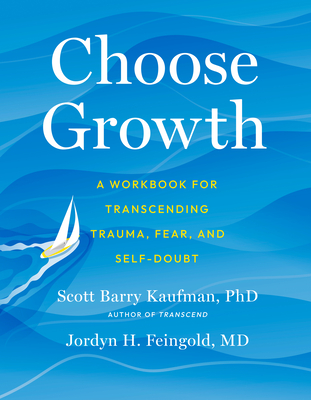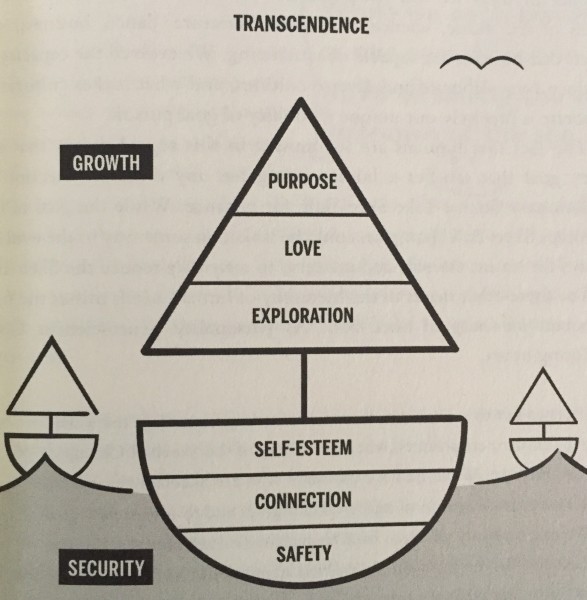SNQ: Scott Barry Kaufman and Jordyn H. Feingold’s “Choose Growth”
by Miles Raymer

Summary:
Scott Barry Kaufman and Jordyn H. Feingold’s Choose Growth is a direct response to the COVID-19 pandemic. In an effort to transform our collective trauma into an opportunity for reflection and posttraumatic growth, Kaufman teamed up with Feingold to expand and operationalize the research from his previous book, Transcend, which upgraded Abraham Maslow’s hierarchy of needs using a sailboat metaphor:

Chose Growth takes the reader on a brief but detailed tour of the sailboat, starting with basic security needs, working up toward growth needs, and ending with advice on how to “become a transcender.” Filled with accessible research summaries and practical suggestions for how to live better, Choose Growth should prove an effective tool for anyone seeking to understand and walk the path of human flourishing.
Key Concepts and Notes:
- SBK’s Transcend was my favorite nonfiction book of 2020, so I was excited to see that Choose Growth was a continuation of that work. It was also well-timed for me personally because I am in my first year of graduate school in counseling psychology, and plan to use SBK’s sailboat model as one of the foundational theories in my future practice.
- I think Maslow would celebrate not just SBK’s modification of the hierarchy of needs, but also his completion of Maslow’s “Theory Z”––the suggestion that “self-actualization is just a bridge to transcendence” (144). SBK’s concept of “healthy transcendence” is the logical extension of Maslow’s legacy.
- Feingold, a former student of SBK’s, seems like an important person to watch in the decades to come. Choose Growth is a solid step in her efforts to promote the new field of “positive medicine”––a healthcare-based extension of the positive psychology movement.
- Overall, this book is incredibly well-researched. Readers can be confident that they are engaging with an evidenced-based approach to self-help. With the exception of the sailboat metaphor, the content isn’t particularly novel, but it’s presented in a way that’s easy to digest, remember, and put into practice.
- I didn’t complete all the recommended practices/exercises, so I can’t speak directly to their efficacy. But I reviewed all of them and think they have a lot of potential, especially when selectively applied to areas where a particular person happens to be underdeveloped. The book seems like a terrific resource for therapists looking to help clients explore and articulate their basic needs, values, and goals.
- Personally, I found the advice on how to manage anxiety to be very helpful. I love the idea of personifying this emotion, thanking it for looking out for me, and then telling my anxiety that it’s no longer needed. I’ve come across this idea before but Choose Growth really solidified it for me.
- SBK and Feingold do a good job of acknowledging that systemic injustice, structural dysfunction, bad luck, and group identities play a significant role in mental health, but they mostly focus on meeting universal needs, drawing out our common humanity, and treating people as individuals. This positive, inclusive approach zeroes in on the aspects of our cognition and personal lives that are within our control, fostering a sense of possibility and empowerment.
- I love that SBK and Feingold explicitly reject the idea of a “best self.” I think a lot of people get stuck on this notion that their goal in life should be to discover and become their best self, but it turns out that’s just not how the human body-mind works. Each person is “a bundle of various and sometimes conflicting impulses, emotions, roles, and drives” that can either be suppressed or amplified by a huge variety and internal and external stimuli (84). The goal, therefore, should be to identify, create, and maintain the circumstances in which our best potentialities tend to arise. This process is ongoing and endless throughout the lifespan. We’ll never arrive at a “best self,” and in fact we shouldn’t want to because that would mean the end of growth.
- In general, I think Choose Growth represents the our best available model for how people can live well, one that honors our shared humanity and also delights in our individual differences.
Favorite Quotes:
Let us embrace what is human about all of us and seize this collective opportunity to grow, personally and collectively. Underneath our tribalism and arbitrary ways of dividing each other, we all have the same basic needs for safety, connection, self-esteem, and love, and we all want to matter, to find meaning, and to live a vital life. (xviii)
Choosing growth today is a way to honor our past, live more deliberately in the present, and nurture the future we hope for. To choose the path of growth is to integrate all the various parts of ourselves and uplift the completeness of our human experience. This process involves learning, accepting, and integrating all parts of ourselves, including those dark parts that we may wish to suppress or tuck away. It is when we harmonize these parts of ourselves that we may cultivate greater compassion, connect more deeply with others, extract more meaning and joy from life’s lessons, and ultimately contribute to the world in ways that are authentic, gratifying, and synergistic with those around us. (xxi)
As we move through life and aim to cultivate growth, one of the most high-yield investments we can make is a steadfast commitment to our relationships. The people we surround ourselves with, physically, virtually, emotionally, and spiritually, shape our realities in profound ways. Robust bodies of research show that happiness, health, and well-being are not just functions of our individual experience, but rather are properties of the groups we are a part of. (28)
For decades to come, the era of COVID-19 will provide a common reference point and language for all humans on the planet who lived through this time to connect, share stories, and relate to one another. A conversation starter with a stranger on an airplane, a fellow patron in a restaurant, first-date fodder, tales for our grandchildren one day: We will likely all be talking about this moment in history, and how it changed us, for the rest of our lives.
Stories connect us, reinforce our sense of purpose, and provide us with a path forward to close the gaps between the realities we lead and those which we imagine. They can help us integrate the darkness of our lives into our narrative, and perhaps even emerge from and grow from that darkness. (138)
Healthy transcendence is not about being more enlightened than others, but about being more authentic to ourselves and synergistic with the world. What is good for us is good for others. What we love to do, or that which we are even called to do, positively impacts others. There is a great connection between self and world. We don’t choose ourselves over others, and we also don’t choose others over ourselves. There is a harmonious integration between self and world. (144)
In daily life we often fall subject to the defense of “splitting” or resort to “all-or-nothing thinking”…However, making room for uncertainty by practicing “yes, and” with ourselves and others can help us honor the complexity and richness of our full human experience, and to not only tolerate but embrace and revel in the complexities, contradictions, and gray areas we live in…
Whereas “yes, but…” narrows the possibilities and places conflicting experiences and views at odds with one another, “yes, and” helps us to enthusiastically accept the totality of an experience; validate, rather than undermine conflicting impulses or feelings; and thereby foster mutual, positive regard with ourselves and others. (166)
While we’re each in our own boats traveling in our own individual directions, we really are inextricably connected to and interdependent on one another. Our own actions, even within our own boats, have rippling effects, creating tides and wakes that impact those around us as well as those who will come after us. (171)
I’ve never been much for self help books but I might check this one out based on your review. Especially interesting was the part about managing anxiety, which I think is a pretty common state given the past several years of one global disaster after another.
Thanks Todd for reading and leaving this comment! If you prefer a non-self-helpy version of these ideas, you could always check out SBK’s “Transcend.” There is a ton of overlap with the research content and it’s a more traditional popular science book if you might find that more approachable. Happy reading! 🙂